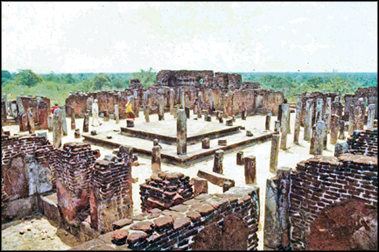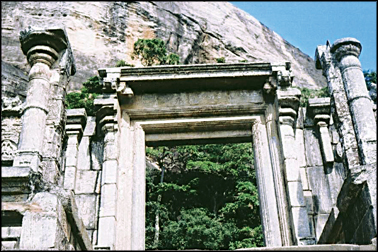The Sinhala kings in action
KAMALIKA PIERIS
On several occasions the Sinhala king had to protect his kingdom from
external forces. One invasion was by a Malay prince, Chandrabanu. The
other challenges were from India. They included invasions by the
Rashtrakuta and Vijeyenagar kings. They ruled from Karnataka.
 |
|
Ruins of
the historical buildings constructed by King Parakramabahu. |
These invasions were repelled. Muslims from the Coromandel coast of
South India, under the leadership of Cader Shar invaded the island in
the time of Buvaneka bahu I (1272-1284). They were defeated but many of
the soldiers were allowed to remain here. They are said to have settled
in the north-western part of the island.
There were many attempts to bring Sri Lanka under the control of the
Tamil kings. But the Sinhalese were not prepared to submit to Tamil
rule. No Tamil dynasty was allowed to take root.
Whenever Tamil kings or Tamil chiefs occupied Sri Lanka, the Sinhala
royalty moved to another part of the island and functioned from there.
The Sinhala kings were very determined in this matter. Regardless of how
long it took, they watched, waited and eventually pushed the Tamils out.
Dutugemunu, Vattagamani, Dhatusena, Vijayabahu I and Vijayabahu III
expelled Tamil invaders. Vijayabahu III, after getting rid of Magha,
built fortresses in Wattala, Yapahuwa, Vakirigala and Kurunegala. The
confidence with which the Sinhala king handled the Tamil invasions and
their repulsion of repeated invasions show that the Sinhala king was not
in awe of the Tamils.
The Sinhala king did not hesitate to use aggression to defend his
trade rights. Parakrama bahu I had a military strike against Myanmar and
Parakrama bahu VI sent a force to Tamilnadu when Sinhala traders were
obstructed in their trading activity.
In the time of Dharma Parakramabahu (1489-1513) Arabs headed by the
pirate Kadirayana invaded Sri Lanka. They fished for pearls at Chilaw
and captured elephants. They were subdued, their vessels destroyed and
eighty nine were taken captive by the king’s brothers on the king’s
orders. Francois Valentijn writing in 1726 corroborates the Rajavaliya
account. Dewaraja remarks that this appears to be a plundering raid by
pirates rather than an attempt to take territory.
Superb
I think that as a general rule, the king was expected to use
diplomacy in preference to force. The foreign intelligence available to
the Sinhala king was superb. He knew of the rise of Islam. In the 7th
century, the Sinhala king (probably Aggabodhi III) had sent an embassy
to the Prophet Mohammad.
By the time the envoy reached Medina the Prophet as well as the first
Caliph, Abu Bakr, had died, so he met the Caliph Umar. On the return
journey the envoy also died, and his servant returned to make a report
to the Sinhala king. This event has not received the attention it
deserves. It shows that the Sinhala king not only had excellent foreign
intelligence, he could also gauge the importance of the information he
received.
Marriage alliances were used to strengthen the royal position.
Marriages were made with the royal houses of south India, the Deccan and
occasionally with kingdoms of the north such as Kanauj. Suttamalli, the
daughter of Eastern Chalukya king Kullotunga I (1070-1122), married
Virapperumal, a Sinhala prince. When Kullotunga inherited the Chola
throne, he did not attempt to recapture Sri Lanka.
Mitta, sister of Vijayabahu I was given in marriage to a Pandya
prince in preference to a Chola prince. Goonetilaka says that according
to G.H. Luce, the rulers of south east Asian countries, specially
Cambodia and Myanmar (Burma) were eager to have consorts from Sri Lanka.
A Sinhala princess was sent to Cambodia during the time of Parakrama
bahu I. According to Glass Palace Chronicle, Burmese king Alaungsithu,
visited Sri Lanka, married the Sri Lanka king’s daughter and retuned to
Burma. This episode is not mentioned in Sri Lanka sources.
Open invitation
 |
|
King Vijayabahu III built Yapahuwa
fortress to wage war against the enemies. However, today
Yapahuwa is considered to be a place of worship for
buddhists. |
Historians sometimes devalue the Sinhala king when interpreting
historical events. Buvanekabahu I sent an embassy in 1283 to the Mamluk
court of Egypt. The embassy was led by Al -Haj-Abu- Uthman. He handed
over a letter from the king and explained it contents verbally since the
letter was in Sinhala. In his letter the king stated that he had
rejected an embassy from Yemen in preference to one from Egypt.
He desired an Egyptian ambassador to be sent to Sri Lanka. He
extended an open invitation to Egyptian merchants to trade with Sri
Lanka. He offered to export many items including pearls, cinnamon,
precious stones, hardwoods and elephants. He also offered to build
twenty ships per year. The outcome of this embassy is not known, but
coins belong to the Babri Mamluks of Cairo have been discovered in Sri
Lanka. A number of them belong to Sultan Qulaum (1279-1290) who received
the envoy of the Sinhala sovereign.
Historians have suggested that this embassy was initiated by the
Muslim traders in Sri Lanka, not the Sinhala king. They say there was a
powerful Muslim lobby operating in the Sinhala court. This lobby had
wished to restore Sri Lanka’s flagging economy by establishing direct
trade relations with Egypt which by this time had superseded Baghdad.
This interpretation cannot be accepted. The Sinhala king had been
engaged in diplomatic relations for centuries, long before Islam began.
Buvaneka bahu was neither weak nor indecisive. He took the throne
after killing the commander in chief of the army, who had usurped it. He
also defeated a Tamil invasion by Marvaraman Kulasekhara Pandya. It is
unlikely that he would have needed instruction on either diplomacy or
trade. The letter to Egypt shows a very confident monarch. The contents
of the letter do not indicate a ‘flagging economy’ either. I do not
think the Muslims were important in the royal court. When Ibn Batuta
visited in 1344, he was not taken before the king. I think that the king
would have commanded Uthuman to take the letter to Egypt, not the other
way round.
(The writings of M. Azeez, H. Goonetilake, L. Dewaraja, S. Kiribamune,
C.W.Nicholas, K.A.Nilakanta Sastri, S. Paranavitana, W.I. Siriweera and
S.M.Yusuf were used for this essay). |



